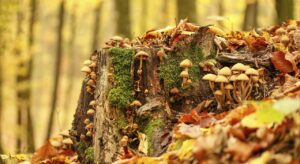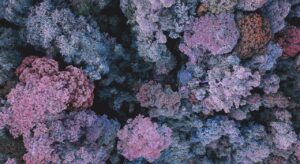Woody plants have different life forms according to their appearance and the nature of their growth: trees, shrubs, and bushes. Trees are plants that have one perennial stem called a trunk.
The thickness of trees is characterized by the diameter of the trunk, which for convenience is measured at the height of the human chest – 1.3 m from the ground and is expressed in centimeters. With the dying off of the trunk, the life of the tree ceases.
Shrubs – plants in which the main trunk is not expressed, and there are several trunks, going from the base (root neck).
In terms of size shrubs are subdivided into high – above 2.5 m, medium – 1-2.5 m and low – 0.5-1 m.
Representatives of shrubs – hazel forest, honeysuckle, currant, rakitnik, etc.
Structure. Woody plants are higher plants. All of them have leaves, a stem and roots. The stem of these plants is called the trunk and is covered by bark on the outside. The stem moves water and minerals from the roots to the leaves, and organic matter from the leaves to the roots. Some of these substances are deposited in the trunk. The top of the trunk branches off into twigs and shoots to form the crown. Leaves, buds, and flowers are found on annual and perennial shoots. The roots of a woody plant absorb water and nutrients from the soil, serve also as a place of deposition of spare organic substances and support for the entire plant. The place where the root passes to the stem is called the root neck, it is located at the very surface of the soil.
According to the nature of its structure, it can be stubby, taprooted, superficial and mixed. A corm-like root system has no main root, all of which are thin, like those of herbaceous plants, bunched up from the root neck. Such roots are characteristic of monocotyledonous plants: bamboos, palms, etc. The tap root system has a deep main root and thinner lateral roots. This root system is characteristic of oak, pine, larch. Surface root system is characterized by poorly developed tap root and thick lateral roots at the very surface of the soil. It is found in spruce, aspen, shrubs, and pine and larch growing in waterlogged and poor sandy soils. Tree species with a superficial root system are prone to wind-blown, that is, when a strong wind blows, they turn out together with their roots. Mixed root system consists of well-developed taproot and lateral roots (maple, linden, etc.).
The main mass of roots is concentrated in the most fertile upper meter layer of soil, deeper (up to 8-10 m) single roots penetrate.
Many woody plants have mycorrhiza (mushroom root) on their roots in the form of fungal threads covering the thin roots. Mycorrhiza is a phenomenon of symbiosis between a fungus and a plant.
On the roots of plants of the legume family (yellow acacia, rachnitz, etc.) nodules are formed as a result of the activity of nodule bacteria that assimilate atmospheric nitrogen, which becomes available to plants, which improves their nutrition.
Growth
Growing trees and shrubs are perennial plants. They increase their size each year and form new organs. Leaves, shoots, roots, flowers, and fruits are constantly renewed.
Growth in height is due to the formation of new shoots from apical buds at the ends of old shoots. If the apical bud dies, the central shoot grows from the nearest side bud. The shoots of some species take 10-12 days to grow (oak), others take a few weeks (poplar).
With the end of growth, an apical bud is formed. Sometimes second and third growth in height is observed in oaks.
The trunk, twigs and shoots of a tree consist of wood and bark. If you cut off the trunk at the neck of the root, you can tell the age of the tree by the number of annual rings of wood.
Longevity of tree species varies widely: from a few years (bamboo) to several hundreds or even thousands of years (sequoia). Longevity also varies within one species (breed) depending on internal and external reasons.
Reproduction of tree species occurs by seed and vegetative methods.
The main method is the seed method. The age at which fruiting begins is called the age of maturity. It depends on both the species characteristics of the plant and its living conditions. Tree species can bear fruit every year, but heavy harvests, or seed years, are said to be less frequent. It depends on how favorable conditions were during all stages of fruiting: from the establishment of flower buds to fruit ripening. Very often spring frosts and pests damage flowers and ovaries, destroying the harvest of seeds.


